Biology Of Tooth Movement Important Notes
- Hyalinization – characteristics
- Tissue degeneration
- Acellular, avascular area
- Deposition of clear eosinophilic homogenous substance in periodontal ligament
- Optimum orthodontic forces
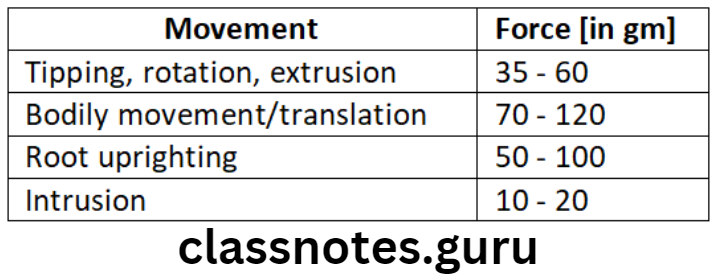
- Phases of tooth movement
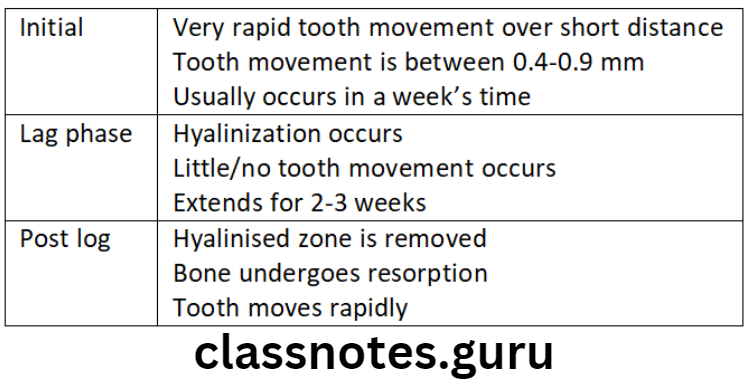
- Torqueing/reverse tipping
- During it there is movement of root only without movement of crown
- Used to correct effects of uncontrolled tipping
- Frontal resorption
- Occurs on application of light forces
- Amount of force applied is close to capillary pressure
- Rearward resorption
- Occurs on application of heavy forces
- Forms hyalinised zones
- Changes on application of forces
- Stretching of PDL fibres on tension side
- Raised vascularity
- Mobilization of fibroblasts and osteoblasts
- Formation of osteoid
- Formation of woven bone
Biology Of Tooth Movement Long Essays
Question 1. Define optimum orthodontic force. Discuss various theories of tooth movement.
Answer.
Optimum Orthodontic Force:
- It is a force which rapidly moves teeth in desired position with minimum damage to adjacent tissues and with less discomfort to the patients
- Value: According to Oppenheim and Schwarz, it is equal to capillary pressure i.e. 20-26gm/cm2
Theories Of Tooth Movement
Pressure – Tension theory – By Schwarz:
- On application of force to tooth, 2 areas are formed
- Pressure area – in direction of force
- Tension area – in opposite direction
- Results in:
- Bone resorption in pressure area
- Bone deposition in tension area
- Bone resorption in pressure area
- Results in:
Read And Learn More: Orthodontics Short And Long Essay Question And Answers
Fluid-Dynamic Theory – By Bien:
Proposed by: Bien
Theory: Tooth movement occurs as a result of alterations in fluid dynamics in the periodontal ligament

- Has limited passage of fluids
- Removal of force of short duration causes replenishment of this fluid
- While forces of greater magnitude leads to squeezing out of fluid
- Results in decreased tooth movement called squeeze film effects
Changes Of Optimum Orthodontic Forces:
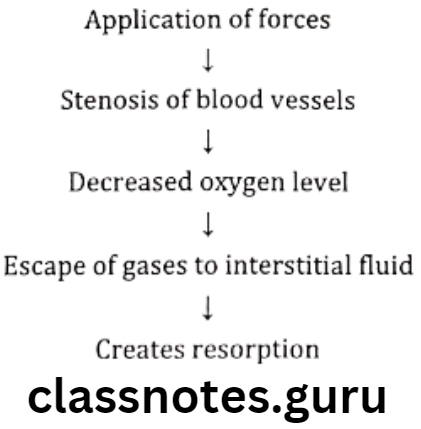
Bone Bending and Piezoelectric Theory – By Farrar:
- Piezoelectricity is a phenomenon observed in many crystalline materials in which a deformation of the crystal structure produces a flow of electric current as a result of the displacement of electrons from one part of the crystal lattice to another
- Sources of Electric Current:
- Collagen
- Hydroxyapatite
- Collagen-hydroxyapatite interface
- Mucopolysaccharide
Piezoelectric
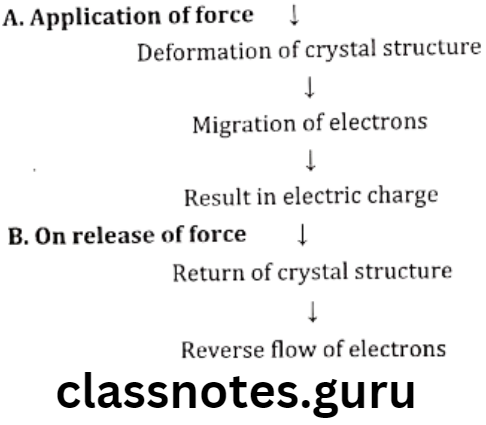
Bone Bending:
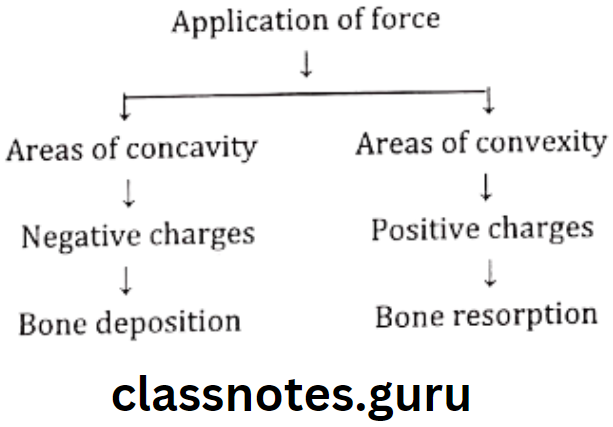
Question 2. Discuss histological changes during orthodontic tooth movement.
Answer.
Orthodontic forces leads to the formation of areas of pressure in the direction of force and areas of tension in the opposite direction around the tooth
Changes Due To Mild Forces:
- On the pressure side:
- Compression of PDL
- Increase in blood supply
- Increase in fibroblasts and osteoblasts
- Parallel arrangement of bony trabeculae
- Resorption of the alveolar plate adjacent to the ligament called frontal resorption
- On the Tension side:
- Stretching of the periodontal membrane
- Widening of PDL space
- Increased vascularity
- Presence of fibroblast and osteoblast
- Formation of osteoid
- Secondary remodeling changes:
- Bony changes occurs else where to maintain thickness of alveolar bone
- Called secondary remodeling
- Ex. For labial movement of tooth deposition occurs on labial cortical plate and resorption over lingual cortical plate
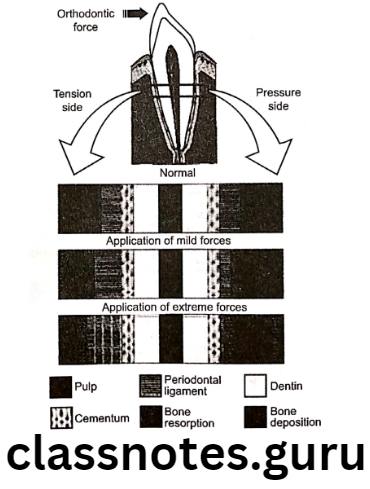
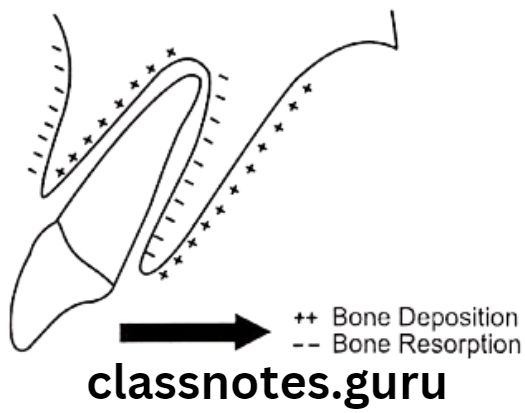
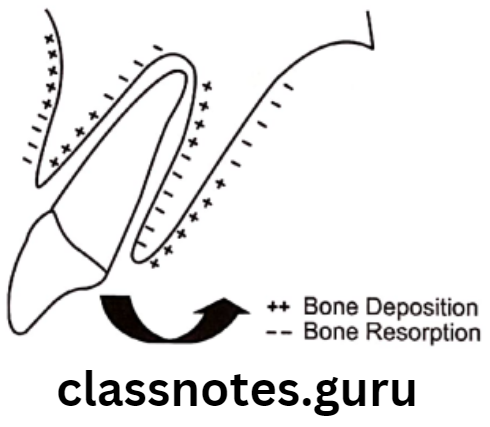
Changes Due To Extreme Forces:
- Pressure side:
- Crushing of PDL
- Approximation of root to lamina dura
- Occlusion of blood vessels
- Deprived blood supply
- Regressive changes occur called hyalinization
- Bone resorption in marrow spaces below behind and above hyalinized zones
- Called undermining resorption
- Tension side:
- Over stretching of PDL
- Tearing of blood vessels
- Ischaemia
- Effects:
- Increased osteoclastic activity
- Loosening of tooth
- Pain and hyperemia of gingiva
- Effects:
Biology Of Tooth Movement Short Essays
Question 1. Undermining Resorption.
Answer.
Undermining Resorption
- Occurs on application of extreme, orthodontic forces
- Occurs on pressure side i.e. in direction of force application around tooth
Changes Of Undermining Resorption:
- Crushing of periodontal ligament
- Approximation of root to lamina dura
- Occlusion of blood vessels
- Deprived of blood supply
- Hyalinized zones formation
- Resorption occurs below, behind and above hyalinized zones
- This is called undermining resorption
Synonym: Rear ward resorption
Question 2. Hyalinization.
Answer.
Hyalinization
- It is tissue degeneration characterized by formation of a clear, eosinophilic homogenous substance
Location Of Hyalinization:
- Kidneys, lungs etc.
- Irreversible
- But in PDL – Reversible, Bony spicules
Effects Of Hyalinization:
- Shrinkage of PDL fibres
- Pyknotic nuclei formation
- Union of collagenous fibres
- Breakdown of blood vesses walls
- Osteoclasts in marrow spaces
- Non-functioning of ligament
- Absence of resorption
Elimination By:
- By resorption of alveolar bone
- Invasion of cells and blood vessels from periphery
Importance Of Hyalinization:
- Greater forces – Wider hyalinized area
- Functionless large area of ligament
- Large area of rearward resorption
- Tipping movement – hyalinized zone close to alveolar creast
- Bodily movement – Close to middle portion of root

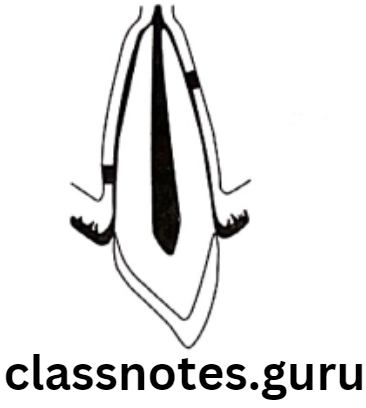

Question 3. Tissue changes in Tipping movement.
Answer.
Mild Forces:
Secondary remodeling changes occurs:
- Osteoclatic activity on pressure side
- Osteoblastic activity on tension side
For labial tipping:
- Deposition on outer side of labial alveolar bony plate
- Resportion on lingual side of lingual alveolar bone
Significance: Maintain uniform thickness of bone
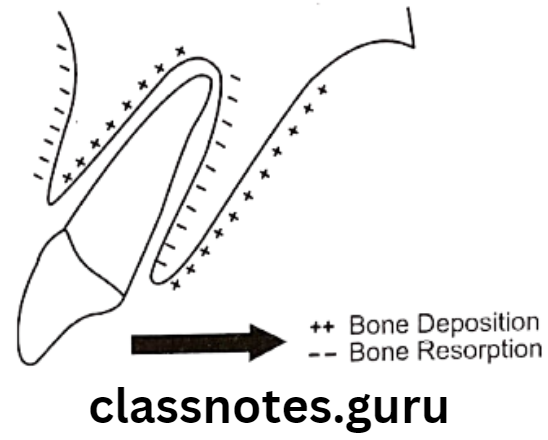
Hyalinization: Hyalinized zones are seen close to alveolar crest
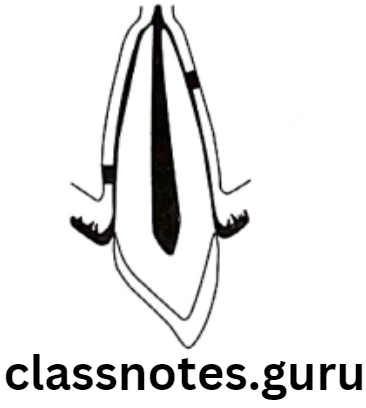
Extreme Forces:
- It results in formation of hyanilized zones at 2 regions
- At apical area
- At marginal area
Question 4. Optimum Orthodontic Force.
Answer.
Optimum Orthodontic Force
- It is a force which rapidly moves teeth is desired position with minimum damage to adjacent tissues and with less discomfort to the patients
Value: According to Oppenheim and Schwarz, it is equal to capillary pressure i.e. 20-26gm/cm2
Properties Of Optimum Orthodontic Force:
- Rapid tooth movement – Clinically
- Less patient discomfort – Clinically Minimum lag phase – Clinically
- Absence of tooth mobility – Clinically
- Maintenence of tooth vitality – Tissue level
- Maximum cellular response – Tissue level
- Frontal resorption – Tissue level
Question 5. Frontal Resorption.
Answer.
Frontal Resorption
- Occurs on application of mild forces to bring about tooth movements
- Occurs on pressure side
Changes Of Frontal Resorption:
- Compression of PDL
- Increased vascularity
- Increased blood supply
- Presence of fibroblast and osteoclast
- Orientation of bony trabeculae parallel to the direction of force application
- Osteoclasts starts resorption adjacent to ligament
- This type of resorption is called frontal resorption
Question 6. Piezo-electric theory.
Answer.
By Farrar:
- Piezoelectricity is a phenomenon observed in many crystalline materials in which a deformation of the crystal structure produces a flow of electric current as a result of displacement of electrons from one part of crystal lattice to other
Sources of Electric Current:
- Collagen
- Hydroxyapatite
- Collagen-hydroxyapatite interface
- Mucopolysaccharide
Piezoelectric:


Question 7. Frontal v/s rearward resorption
Answer.
Frontal v/s rearward resorption
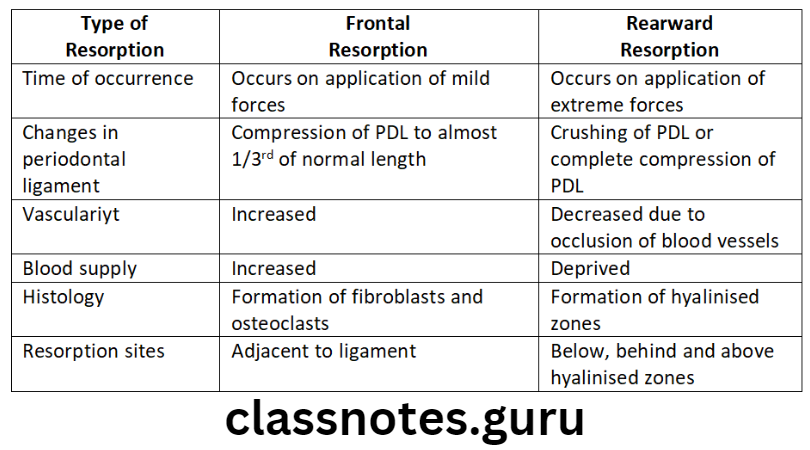
Question 8. Risk of orthodontic treatment.
Answer.
Risk of orthodontic treatment
- Toothache, occasional discomfort
- When beginning of orthodontic treatment and during each inspection, unpleasant pressure over teeth is present
- Scratches and bruises
- Bruises may occur on mucosa generally caused by fixed appliances
- White spots on the surface of teeth
- Occurs due to long term bad oral hygiene
- White patches appears around the brackets
- Gingivitis
- Insufficient oral hygiene may lead to gingivitis
- Root shortening
- Orthodontic appliances exerts force onto roots of the teeth
- The compressive force is always generated over root surface
- This reduces the blood supply
- Results in some of the root surface dissolving away temporarily leading to shortening of root
- Relapse of orthodontic treatment
- Every orthodontic treatment has a tendency to relapse
- This can be prevented by use of retainers
- Tooth decay
- Due to fixed appliances tooth cleaning becomes difficult
- Due to this number of bacteria increases leading to tooth decay
- This can be prevented by
- Avoiding sugary foods and drinks in between meals
- Maintaining oral hygiene
- Use of fluoridated toothpaste
- Use a daily mouthwash containing fluoride
Biology Of Tooth Movement Short Questions And Answers
Question 1. Pressure Tension theory
Answer.
By Schwarz:
- On application of force to tooth, 2 areas are formed
- Pressure area – in direction of force
- Tension area – in opposite direction
Results in:
- Bone resorption in pressure area
- Bone deposition in tension area
Question 2. Biochemical Reactions of Orthodontic force.
Answer.
Biochemical Reactions of Orthodontic force
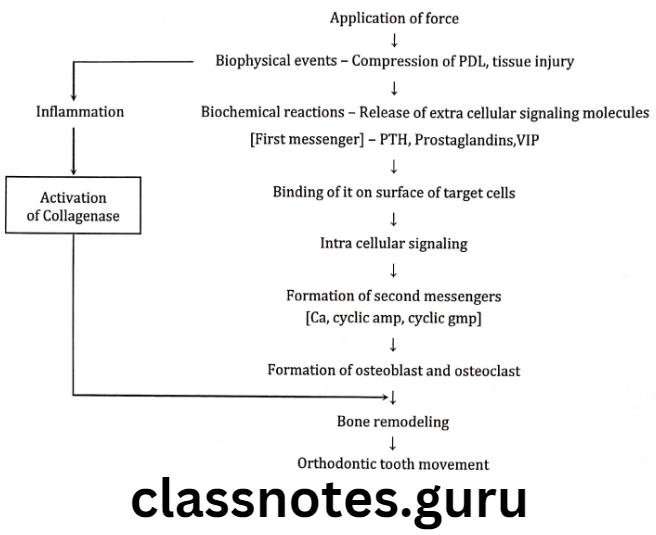
Question 3. Tissue changes on pressure side.
Answer.
- Changes due to mild forces
- Compression of PDL
- Increase in blood supply
- Increase in fibroblasts and osteoblasts
- Parallel arrangement of bony trabeculae
- Resorption of alveolar plate adjacent to ligament called frontal resorption
- Changes due to extreme forces:
- Crushing of PDL
- Approximation of root to lamina dura
- Occlusion of blood vessels
- Deprived blood supply
- Regressive changes occur called hyalinization
- Bone resorption in marrow spaces below behind and above hyalinized zones
- Called undermining resorption
Question 4. Tissue changes in tipping movement.
Answer.
Mild Forces:
- Secondary remodeling changes occurs:
- Osteoclatic activity on pressure side
- Osteoblastic activity on tension side
- For labial tipping:
- Deposition on outerside of labial alveolar bony plate
- Resorption on lingual side of lingual alveolar bone
Significane: Maintain uniform thickness of bone
- For labial tipping:
Hyalinization: Hyalinized zones are seen close to alveolar crest

Question 5. Optimum orthodontic force.
Answer.
Optimum orthodontic force
- It is a force which rapidly moves teeth in desired position with minimum damage to adjacent tissues and with less discomfort to the patients
- Value: According to Oppenheim and Schwarz, it is equal to capillary pressure i.e. 20-26gm/cm2
Question 6. Hyalinization.
Answer.
Hyalinization
It is tissue degeneration characterized by formation of a clear, eosinophilic homogenous substance
Location Of Hyalinization:
- Kidneys, lungs etc.
- Irreversible
- But in PDL – Reversible, Bony spicules
Effects Of Hyalinization:
- Shrinkage of PDL fibres
- Pyknotic nuclei formation
- Union of collagenous fibres
- Breakdown of blood vessel walls
- Osteoclasts in marrow spaces
- Non-functioning of ligament
- Absence of resorption
Biology Of Tooth Movement Viva Voce
- Application of light forces will result in frontal resorption
- Application of extreme forces will result in undermining or rearward resorption
- Tipping is most common and most simplest type of movement
- Intrusion and translation are difficult to achieve
- Extrusion is easiest of all movements
